- Joined
- Dec 19, 2012
Just some background. I have a fairly good 6700k but when I tried it under LN2 it was a total fail IMO. My take from the chatter on the internet is that first, the new tim isn't very good ambient and second, it's terrible cold. So I decided to pop my first Intel. I have documented my steps with pics to hopefully help others. The new Skylake PCB is a lot thinner than previous generations so the vice method is not going to work. That leaves the razor. I have de-lidded AMD in the past that were soldered on so I figured this would be fairly easy and it was. There aren't any obstructions under the IHS like the Haswell so the only thing you have to worry about hitting is the die itself and be careful not to cut into the PCB. I chose the hard back utility razor. it may be a bit thicker than the Gillette but easier on the fingers.
SO here's my victim the usual i7 6700K CPU

Here I'm making the first cut. It can be challenging to get the razor to start between the IHS and PCB but always keep it flat to the board. Tipping it can cause damage to the PCB. Just be patient and slowly "rock" the razor, eventually it will start to slip under the IHS. My best advice here is try not to have too much razor under the IHS, work slowly and take your time it's better than buying another CPU. If you happen to chip the die or cut the PCB it's an expensive lesson. I held it quite tightly in the centre between my thumb and fingers. Never mind my ugly thumb nail that was a fan "accident" a few months ago and trust me it looks and feel a lot better than it did.

OK so the first stage is complete. I opened the CPU with no "accidents" as far as I could tell. I would like to note that the original TIM felt quite dry and brittle.

This next part took me the longest. Cleaning the old glue off. Don't use a razor. I found my fingernail worked quite well and I also used a small plastic tool I have for laptop/phone work. The idea is to get it as clean as possible for the new glue application. Once I had all the glue removed I cleaned all surfaces with alcohol. FYI This part of the process took me the longest, the cleaner it is the better your new seal is going to be.

OK we're almost done now. Time for some new Thermal Paste. I'm using Gelid extreme since my end goal is improved sub-ambient performance. Here's a couple shots. Second one is in the board already spread. Ready for final assembly.


I found this next part to be a bit of a challenge. I used Mono Ultra exterior in black to re-glue. This isn't silicone but I'm sure that would work. The challenge was getting onto the IHS evenly and cleanly. I put a gob onto a piece of paper and then used the Gelid applicator to apply the sealer. You really don't need too much.

OK we're nearly there. Now carefully place the IHS back onto the PCB that's sitting in the board. You'll need to offset the IHS initially toward the hinge of the latch. When the latch is closed it will shift the IHS slightly as it puts pressure on it.

OK now when you close the latch put some downward pressure on the IHS to help keep it in place.

OK so the moment we've all been waiting for. The operation was a success and gave me about a 7c improvement in XTU at 5.1 with 1.41v set in BIOS. Temp dropped from 35c to 28c. The odd thing was I actually scored better with the same setting after the de-lid.
I was also able to run XTU at 5.2, 1.45v set in BIOS which previously I couldn't do, the temp hit 34c. The really intriguing part is that I scored better 1780 than I did with LN2 (-180c pot) at 5.3 which was 1766 at 8c. Which makes me wonder/think that the original TIM wasn't cooling the full die properly and possibly some sections were getting too hot.

I will update this thread when I get the opportunity to run LN2 in the future.
SO here's my victim the usual i7 6700K CPU
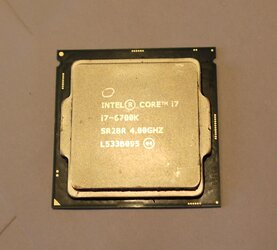
Here I'm making the first cut. It can be challenging to get the razor to start between the IHS and PCB but always keep it flat to the board. Tipping it can cause damage to the PCB. Just be patient and slowly "rock" the razor, eventually it will start to slip under the IHS. My best advice here is try not to have too much razor under the IHS, work slowly and take your time it's better than buying another CPU. If you happen to chip the die or cut the PCB it's an expensive lesson. I held it quite tightly in the centre between my thumb and fingers. Never mind my ugly thumb nail that was a fan "accident" a few months ago and trust me it looks and feel a lot better than it did.
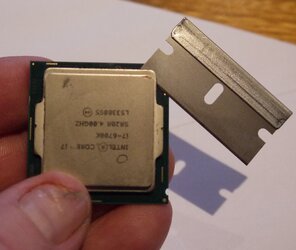
OK so the first stage is complete. I opened the CPU with no "accidents" as far as I could tell. I would like to note that the original TIM felt quite dry and brittle.
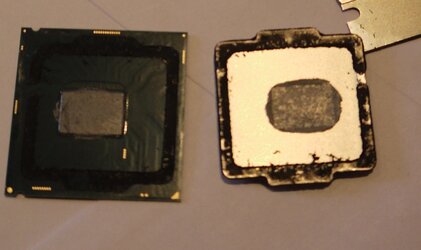
This next part took me the longest. Cleaning the old glue off. Don't use a razor. I found my fingernail worked quite well and I also used a small plastic tool I have for laptop/phone work. The idea is to get it as clean as possible for the new glue application. Once I had all the glue removed I cleaned all surfaces with alcohol. FYI This part of the process took me the longest, the cleaner it is the better your new seal is going to be.
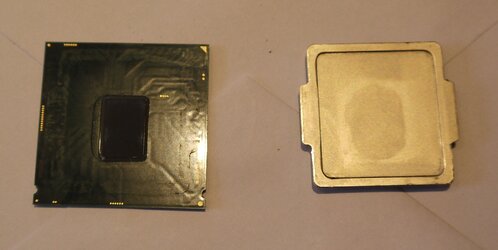
OK we're almost done now. Time for some new Thermal Paste. I'm using Gelid extreme since my end goal is improved sub-ambient performance. Here's a couple shots. Second one is in the board already spread. Ready for final assembly.
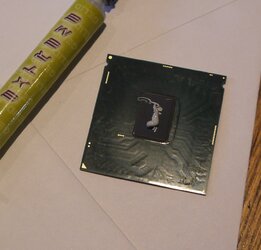
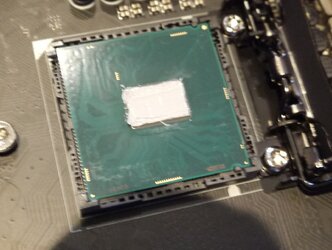
I found this next part to be a bit of a challenge. I used Mono Ultra exterior in black to re-glue. This isn't silicone but I'm sure that would work. The challenge was getting onto the IHS evenly and cleanly. I put a gob onto a piece of paper and then used the Gelid applicator to apply the sealer. You really don't need too much.
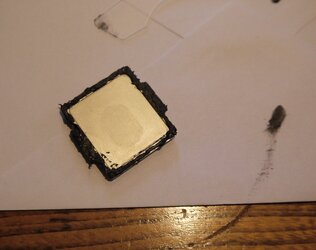
OK we're nearly there. Now carefully place the IHS back onto the PCB that's sitting in the board. You'll need to offset the IHS initially toward the hinge of the latch. When the latch is closed it will shift the IHS slightly as it puts pressure on it.
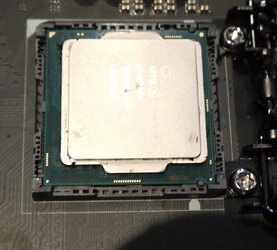
OK now when you close the latch put some downward pressure on the IHS to help keep it in place.
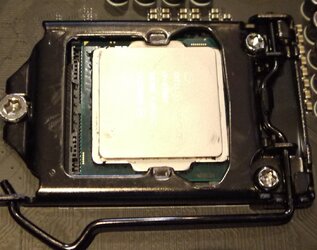
OK so the moment we've all been waiting for. The operation was a success and gave me about a 7c improvement in XTU at 5.1 with 1.41v set in BIOS. Temp dropped from 35c to 28c. The odd thing was I actually scored better with the same setting after the de-lid.
I was also able to run XTU at 5.2, 1.45v set in BIOS which previously I couldn't do, the temp hit 34c. The really intriguing part is that I scored better 1780 than I did with LN2 (-180c pot) at 5.3 which was 1766 at 8c. Which makes me wonder/think that the original TIM wasn't cooling the full die properly and possibly some sections were getting too hot.
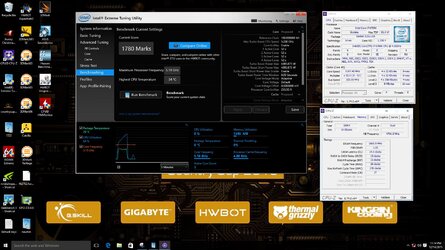
I will update this thread when I get the opportunity to run LN2 in the future.
Last edited:

